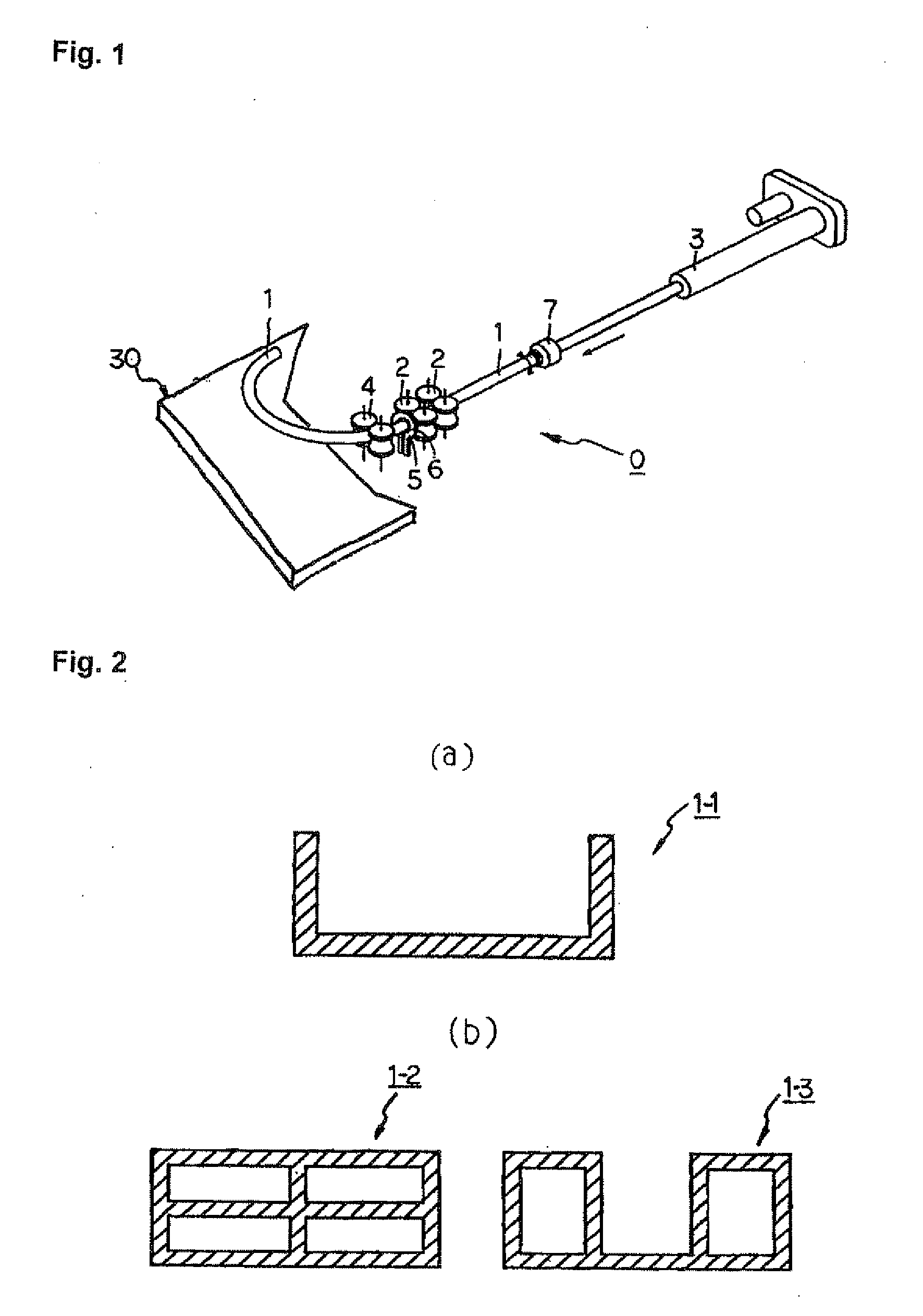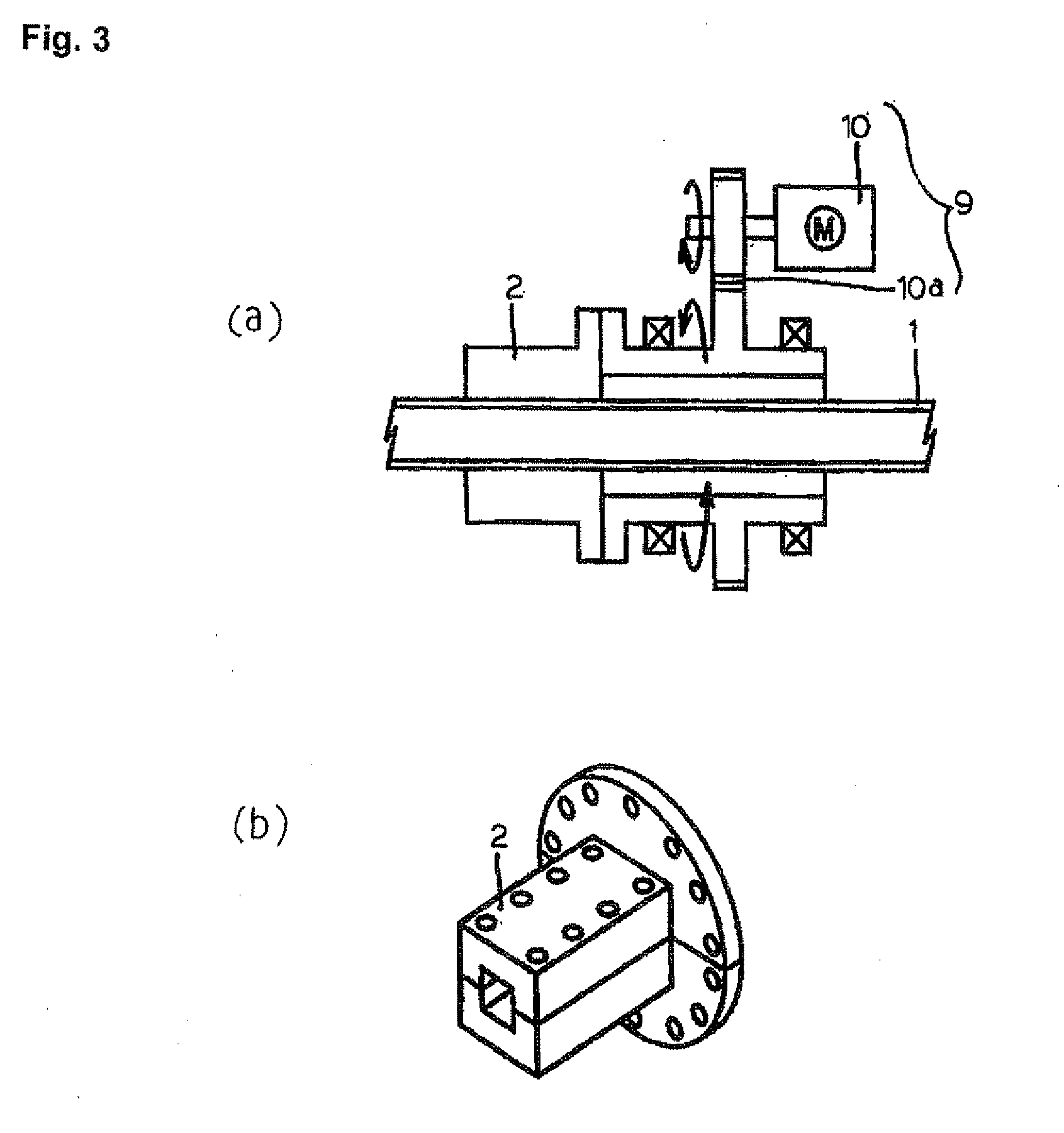Method of manufacturing a bent product and an apparatus and a continuous line for manufacturing the same
a manufacturing method and technology of a continuous line, applied in the direction of shaping tools, heating/cooling devices, furnaces, etc., can solve the problems of inability to achieve desired hardening accuracy, inability to ensure desired hardening accuracy, and difficulty in complex control of cooling rate, etc., to achieve desired dimensional accuracy, high strength, and high strength
- Summary
- Abstract
- Description
- Claims
- Application Information
AI Technical Summary
Benefits of technology
Problems solved by technology
Method used
Image
Examples
example 1
[0225]The present invention will be explained more concretely while referring to examples.
[0226]Using a steel pipe with a wall thickness of 1.6 mm and a square cross section having a height and width each measuring 40 mm as a starting material, a bent product having the external appearance shown in FIG. 24 was manufactured using the bending apparatus according to the present invention which was explained while referring to FIG. 1.
[0227]In this example, bent products prepared in a conventional example which was manufactured without using a support according to the present invention, Example 1 of the present invention which was manufactured using the support guide 30A shown in FIG. 11, and Example 2 of the present invention which was manufactured using the support guide 30B shown in FIG. 12 were measured using a non-contacting three-dimensional measuring device to determine the maximum deviation from a target value (dimensional accuracy).
[0228]The support guide 30A shown in FIG. 11 ha...
example 2
[0232]Using a steel pipe having a wall thickness of 2.1 mm and a circular transverse cross-sectional shape with an outer diameter of 31.8 mm as a starting material, a product having a completely three-dimensional spiral bend and having the external appearance shown in FIG. 28(a) and the dimensions shown in FIG. 28(b) was manufactured using a bending apparatus according to the present invention which was explained with respect to FIG. 1.
[0233]Products of Conventional Example 2, which was manufactured without using the support of the present invention, and Example 3 of the present invention, which was manufactured using the support guide 30G shown in FIG. 17, were measured using a non-contacting three-dimensional measuring device to determine the maximum value of the deviation from a target value (dimensional accuracy).
[0234]In this example, the support guide 30G shown in FIG. 17 was supported using the articulated robot 31-1 shown in FIG. 35. The support guide was used to clamp the e...
example 3
[0237]Using a steel pipe with a wall thickness of 1.8 mm and a rectangular cross-sectional shape with a height of 50 mm and a width of 70 mm as a starting material, a front side member, which is a reinforcing member of an automobile body, having the two-dimensional shape shown in FIG. 36 was manufactured using the bending apparatus according to the present invention which was explained while referring to FIG. 1.
[0238]Products of Conventional Example 3, which was manufactured without using a support guide of the present invention, and Example 4 of the present invention, which was manufactured using the support guide 30H of FIG. 37, were measured using a non-contacting three-dimensional measurement device to determine the maximum value of the deviation from a target value (dimensional accuracy).
[0239]The support guide 30H shown in FIG. 37 clamped the end of the metal material and had a mechanism which could adjust the clamping angle on a table 53. The table had precision ball screws 5...
PUM
| Property | Measurement | Unit |
|---|---|---|
| tensile strength | aaaaa | aaaaa |
| tensile strength | aaaaa | aaaaa |
| tensile strength | aaaaa | aaaaa |
Abstract
Description
Claims
Application Information
 Login to View More
Login to View More - R&D
- Intellectual Property
- Life Sciences
- Materials
- Tech Scout
- Unparalleled Data Quality
- Higher Quality Content
- 60% Fewer Hallucinations
Browse by: Latest US Patents, China's latest patents, Technical Efficacy Thesaurus, Application Domain, Technology Topic, Popular Technical Reports.
© 2025 PatSnap. All rights reserved.Legal|Privacy policy|Modern Slavery Act Transparency Statement|Sitemap|About US| Contact US: help@patsnap.com



